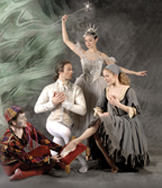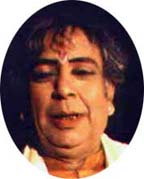Opening Oddities
The Royal Ballet
by John Percival
Many people were puzzled by the make-up of the Royal Ballet's first programme of the new season, and for once director Monica Mason did not contribute an introductory note to the programme book to explain it. So we'll just take it from the advance publicity that the motive was to present three major composers of the 20th century, and (in some versions) three major choreographers too. Well, that's as may be. One point is that the Royal Opera's music director Antonio Pappano was making one of his rare balletic appearances on the rostrum (personally, I think it might have been more rewarding for him to conduct Delibes for the second programme, but there you are ... .READ MORE
Effervescent Wit
Mark Morris's "King Arthur"
by Paul Parish
Sometimes it seems that Mark Morris's work is dividing itself up like George Bernard Shaw's into "Plays Pleasant and Unpleasant." Morris's staging of Dryden and Purcell's "King Arthur," which debuted at the English National Opera, London, last June and has just had its American premiere at UC Berkeley's Zellerbach Hall (where CAL performances had co-commissioned it), is distinctly one of his most pleasant works ever, and indeed, it only got more pleasing the more one saw it. Many returned to see it again, as I did; one acquaintance of mine saw it four times. L'appetite vient en mangeant; the appetite for it grows with the eating, because all the delights are incidental, inexplicable to outsiders, and would not be delightful except for the genius way they are appropriate to the moment..... So you had to be there, and as soon as it was over you wanted to go back. I'd be surprised if sales of King Arthur CDs didn't jump at Amazon.com. READ MORE
"Cinderella" in Chicago
Joffrey Ballet dances Ashton's "Cinderella"
by David Vaughan
 Pickings are slim for Ashton lovers these days; even the Royal Ballet, which after the centenary celebration of 2004 might be thought to have restored his works to the ascendancy in its repertory that they deserve, is offering only a few performances of Rhapsody early next year, and of Symphonic Variations towards the end of the season. So I grabbed the opportunity to see The Joffrey Ballet in its new production of Cinderella at the superb Auditorium Theatre in Chicago. It had long been Robert Joffrey’s wish to add this to the list of Ashton ballets he had been able to secure for his company, and that wish has now been realized, eighteen years after his death, by his co-founder, Gerald Arpino. READ MORE
Pickings are slim for Ashton lovers these days; even the Royal Ballet, which after the centenary celebration of 2004 might be thought to have restored his works to the ascendancy in its repertory that they deserve, is offering only a few performances of Rhapsody early next year, and of Symphonic Variations towards the end of the season. So I grabbed the opportunity to see The Joffrey Ballet in its new production of Cinderella at the superb Auditorium Theatre in Chicago. It had long been Robert Joffrey’s wish to add this to the list of Ashton ballets he had been able to secure for his company, and that wish has now been realized, eighteen years after his death, by his co-founder, Gerald Arpino. READ MORE
A Star Turn
Sylvie Guillem and Russell Maliphant in "Push"
by Lisa Rinehart
For a classical ballerina, Sylvie Guillem has always had too much facility. Her legs are impossibly beautiful, her torso preternaturally lithe and, in à la second, she rests her kneecap against her ear and gives us a big smile. Impressive, yes ... interesting, not always. To Guillem's credit, however, in the later years of her career, she's endeavored to transcend overly mobile hip joints by searching for material challenging her artistry and intelligence. Russell Maliphant, a choreographer Guillem has collaborated with before, and the only choreographer represented in the program of three solos and one duet, doesn't begin to present such a challenge. Maliphant (who performs as well) is as physically pleasing to watch as Guillem, but his choreography is thin and leans toward the self-indulgent. READ MORE
San Francisco Letter No. 16
Lizz Roman & Dancers and Flyaway Productions
by Rita Felciano
Maybe it’s the expense of performing at traditional venues, whose tech costs can be prohibitive, maybe it’s a desire to bring in other than sit-down, look-at the black box audiences, maybe it’s the choreographers’ feeling burdened by the history of dance on stage, but site-specific performances, once an oddity, have become part of the regular local fabric. I remember OnSite Dance Company a few years ago taking over a busy downtown intersection at Noon. A passerby asked her companion what was going on. Without missing a beat, she replied, “Oh nothing, it’s just a dance performance.” READ MORE
“Small Dances About Big Ideas”:
Choreographer’s Commentary Version
Liz Lerman Dance Exchange
by Susan Reiter
 Liz Lerman’s longstanding engagement with the events of the world around her, and the historical precedents that have brought us there, is admirable — and rare, amid the frequent navel-gazing one encounters. The “big ideas” referenced in the title of this work, which originated as a commission by Harvard Law School for a conference marking the 60th anniversary of the Nuremberg Trials, have never scared her off. During the time this piece has been evolving through performances (it premiered November 2005), she has also been developing a new dance work dealing with the issues raised by the human genome project and one exploring contemporary issues of faith and prayer. READ MORE
Liz Lerman’s longstanding engagement with the events of the world around her, and the historical precedents that have brought us there, is admirable — and rare, amid the frequent navel-gazing one encounters. The “big ideas” referenced in the title of this work, which originated as a commission by Harvard Law School for a conference marking the 60th anniversary of the Nuremberg Trials, have never scared her off. During the time this piece has been evolving through performances (it premiered November 2005), she has also been developing a new dance work dealing with the issues raised by the human genome project and one exploring contemporary issues of faith and prayer. READ MORE
Conversations with a Legend
Pandit Birju Maharaj
by Leigh Witchel
 We’re used to performances in Western dance. We go to the theater, buy a ticket, the curtain goes up, we watch (intently, one hopes), the curtain goes down, and then we go home, (entertained and enriched, one hopes). Indian dance can be successfully adapted to Western performance expectations; Nrityagram Dance Ensemble has earned its fame doing exactly that. But like jazz, there are dance forms that a conventional performance cannot fully contain. They are improvisatory by nature and aren’t presented to the viewer; they are conversations and dialogues. The audience’s response — and pure chance — dictate what will happen. READ MORE
We’re used to performances in Western dance. We go to the theater, buy a ticket, the curtain goes up, we watch (intently, one hopes), the curtain goes down, and then we go home, (entertained and enriched, one hopes). Indian dance can be successfully adapted to Western performance expectations; Nrityagram Dance Ensemble has earned its fame doing exactly that. But like jazz, there are dance forms that a conventional performance cannot fully contain. They are improvisatory by nature and aren’t presented to the viewer; they are conversations and dialogues. The audience’s response — and pure chance — dictate what will happen. READ MORE
Many Words, Little Substance
SAKEDance
by Naima Prevots
The press release for the concert was long on words about an exciting focus on “how the world views women,” but the choreography by Sandra Atkinson, Asanga Damask, Kirsten Wilkenson, and guest artist Vladimir Angelov, proved to have little substance. The evening consisted mostly of short solos and duets by the three young women who produced the evening, and they were notably lacking in choreographic invention, artistic projection, and true exploration of the “women’s theme.” The most disappointing feature was Angelov’s “hide-and-seek, find-and-keep” which consisted of clichés showing the three women in childish clothing, running, skipping, holding hands in a circle, and making believe they were playful ten-year-olds. READ MORE